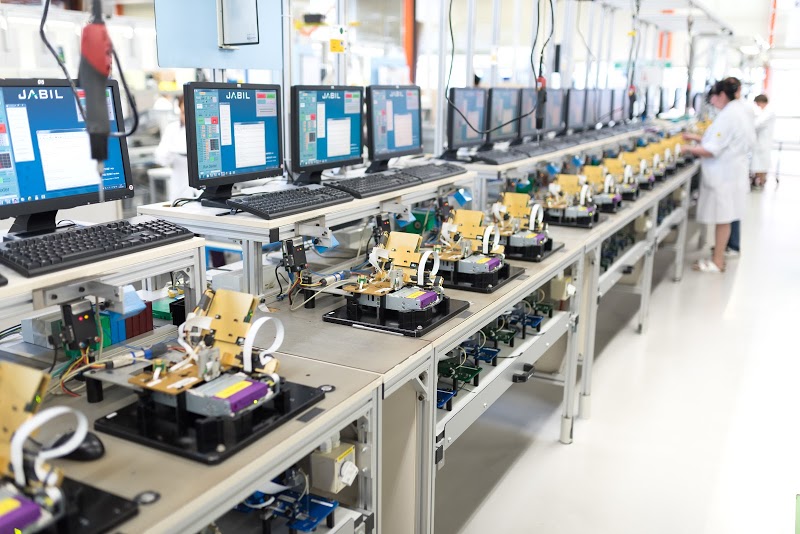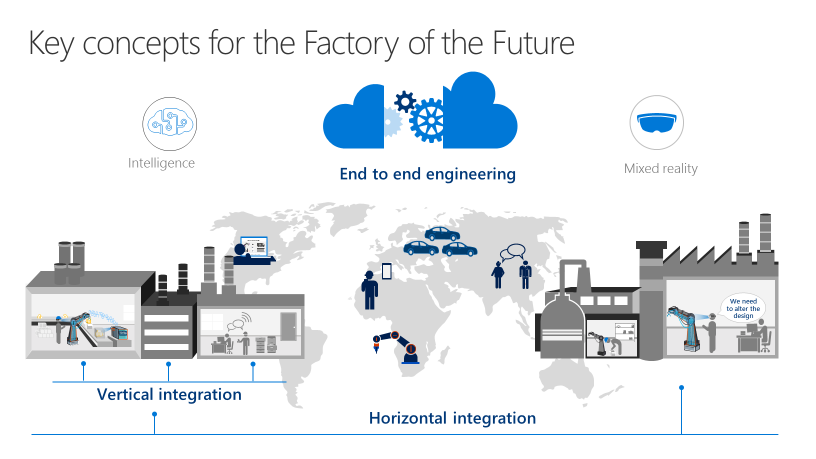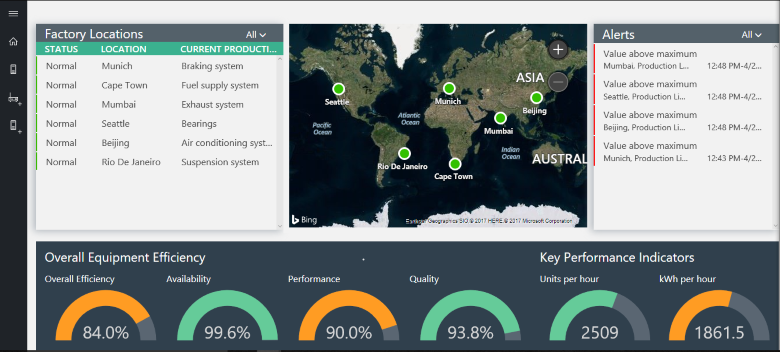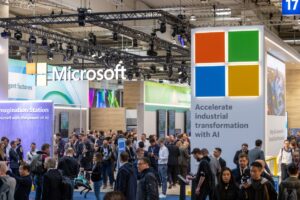
Factories of the future: Meeting the challenge of Industry 4.0
Evolving factories of the future
Once seen as one of the greatest manufacturing innovations of our time, the assembly line revolutionized the industrial era. Today, with Industry 4.0, the lines have blurred between the digital and the physical, both horizontally across organizations and vertically inside the organization, and manufacturing ecosystem is once again transformed. Factories of the future—powered by the industrial internet of things, advanced automation, artificial intelligence and cognitive situational awareness—have catapulted manufacturing into a place where true value co-creation throughout the extended business network is accelerating digital transformation.
In factories of the future, there are virtual manufacturing ecosystems where humans and machines work together like peers, and collaborative robots (cobots) are intelligent enough to contribute across an extended virtual ecosystem. Machine learning, predictive analytics and the cloud powered data-driven insights that let manufacturers know ahead of time when a piece of equipment might fail, instead of having it fail and dealing with the consequences and downtime. The result: yield goes up, the amount of scrap and re-work goes down, and manufacturing cycle time decreases. And with this optimization and rich insights comes the ability for modern manufacturers to embrace customer-centricity, innovate faster, and become more agile.
First movers are already digitizing production
For many manufacturers, factories of the future are already well underway – with more than half having already invested more than $100 million towards smart factories initiatives2. Most manufacturers and analysts believe that achieving end-to-end real-time monitoring is central to improving business processes, but despite big aspirations and investments, only 7% of manufacturers have achieved real-time monitoring across the entire manufacturing process2. For the few manufacturers that have successfully implemented connected, smart factories, the results are powerful: with average realized productivity gains of 17-20%3.
These early successes of digitizing production are showing us what is truly possible with factories of the future. Nowhere was this more evident than at Hannover Messe 2017, where we saw an incredible number of factories of the future initiatives in action in real-world production environments, showing powerful results.
 For example, Jabil is integrating predictive analytics with real-time manufacturing to reduced costs of scrap and re-work by 17%. TetraPak has transformed its production lines with cloud-connected predictive analytics and powerful mixed reality to prevent breakdowns and fix equipment with remote experts. Sandvik Coromant developed a solution that aggregated IoT data in the cloud with cloud analytics that have reduced the time needed to make emergency shutdown decisions from two seconds to 100 milliseconds.
For example, Jabil is integrating predictive analytics with real-time manufacturing to reduced costs of scrap and re-work by 17%. TetraPak has transformed its production lines with cloud-connected predictive analytics and powerful mixed reality to prevent breakdowns and fix equipment with remote experts. Sandvik Coromant developed a solution that aggregated IoT data in the cloud with cloud analytics that have reduced the time needed to make emergency shutdown decisions from two seconds to 100 milliseconds.
In fact, Microsoft’s use of our own technology in our manufacturing operation illustrates how we are maximizing the impact of data to have complete visibility across the value chain—all the way down to the machine or person. This allows us to predict and take action on suppliers, batches, components, lines, and more—empowering every employee to make intelligent decisions on the spot. As a result, we’ve been able to improve yield by 30% and reduce scrap by $2M with predictive insights from machine learning and digitizing the supply chain.
Key concepts for factories of the future
 Factories of the future are complex manufacturing ecosystems of self-regulating machines and sites able to customize output; optimally allocate resources; and offer a seamless interface between the physical and virtual worlds of development, assembly and production. Stand-alone plants can also communicate with other factory sites, merging vast industrial infrastructures already in place with cloud computing and IoT.
Factories of the future are complex manufacturing ecosystems of self-regulating machines and sites able to customize output; optimally allocate resources; and offer a seamless interface between the physical and virtual worlds of development, assembly and production. Stand-alone plants can also communicate with other factory sites, merging vast industrial infrastructures already in place with cloud computing and IoT.
In factories of the future, you have an adaptive open value chain that increases the ability to manufacture personalized products in short product lifecycles. Flexible production systems adapt to customer-driven product design and faster innovation cycles lead to new business models and offerings such as Crowdsourcing, Anything as a Service and Symbiotic Ecosystem.
By adopting advanced technologies, factories of the future also become more human-centered, allowing for easier sharing of knowledge across platforms. Robotic technologies enable workers and machines to collaborate on processes that involve both repetitive tasks and complex decision-making.
Powered by the advanced capabilities of industrial IoT, mixed reality, additive manufacturing, and data analytics, manufacturers can focus on local initiatives that drive efficiency improvements and personalization in production.
How Microsoft is unlocking factories of the future
 The implementation of factories of the future requires technologies to support the seamless integration throughout whole factory’s production networks or manufacturing ecosystems. In the past, industrial automation was driven by a “set it and forget it” mentality. Today, technology is changing that mindset.
The implementation of factories of the future requires technologies to support the seamless integration throughout whole factory’s production networks or manufacturing ecosystems. In the past, industrial automation was driven by a “set it and forget it” mentality. Today, technology is changing that mindset.
Whether you are building from the ground up, or transforming an existing infrastructure, connectivity and interoperability are paramount to success. A world of disparate protocols and systems becomes a synergistic hyperconnected network, with machine-to-machine communication becoming machine-to-machine-to-people communication. Microsoft helps you achieve breakthrough productivity with intelligent, mixed reality and cognitive services by bringing together human, machine, and AI.
Twenty-year-old automation systems enabled by IoT technology provide never-realized insights about operation, productivity and health. Microsoft’s investments in technologies like OPC-UA allow us to seamlessly interface to new and legacy systems, making it simple to connect to the factory you already have.
Key to the success of factories of the future is the use of simulation in the form of the digital twin. While there are a wide variety of technologies at play in digital factories, three of them—artificial intelligence, IoT and mixed reality—are critical to truly achieving a new level of performance with what we call the process digital twin. The power of the twin is no longer just visualization and collaboration of a specific piece of equipment to manage its lifecycle; we can now use the process digital twin to understand the entire manufacturing operation. Microsoft HoloLens takes the digital twin to this new level by allowing manufacturers and their task workers to have an entirely new way to visualize relevant data in the context of their real world.
In factories of the future, safety and security reach new levels with technologies like cognitive services for facial recognition to prevent unauthorized equipment operation. Cyber and physical security are elevated protecting intellectual property, data, and physical assets. Microsoft builds comprehensive security into its products and services by design to help manufacturers protect their data across the physical and virtual worlds.
 Our highly flexible and robust Azure platform helps the hyperconnected world interoperate in hybrid intelligent edge, intelligent cloud models. This provides the foundation for not just an Internet of Things, but an Internet of Things, People, and Services working together in factories of the future.
Our highly flexible and robust Azure platform helps the hyperconnected world interoperate in hybrid intelligent edge, intelligent cloud models. This provides the foundation for not just an Internet of Things, but an Internet of Things, People, and Services working together in factories of the future.
Unlike other software providers, Microsoft brings all of these components together into one holistic offering as a platform for accelerated digital transformation and facilitating the deployment of factories of the future. Our Azure IoT Suite Connected Factory solution connects to and monitors your industrial devices, giving you end-to-end visibility into your production environment. Azure Time Series Insights allows you to analyze the stream of data from your devices and to drive operational productivity and profitability. We have made it as easy as possible to extend the connected factory pre-configured solution with real factories. For this, we have partnered with several industry leaders in the OPC UA manufacturing ecosystem who have built turnkey gateway solutions.
We invite you to get started on the journey to cloud-enable your industrial equipment with Azure IoT Suite Connected Factory. Below are some resources to help you get started realizing the potential of connecting your factory with IoT:
- Watch our webcast for actionable best practices you can implement today.
- Leverage our guide to creating your own connected factory solution.
Factories of the future are a journey. There is not one prescriptive way to get there, and the pace at which you will adopt digital transformation will vary. However, what we do know for sure is that the early adopters are the ones setting the pace and raising the bar for digital excellence. You need to start now, or risk being left behind.
1Zebra, 2017 Manufacturing Vision Study, http://online.zebra.com/mfgvisionstudy




